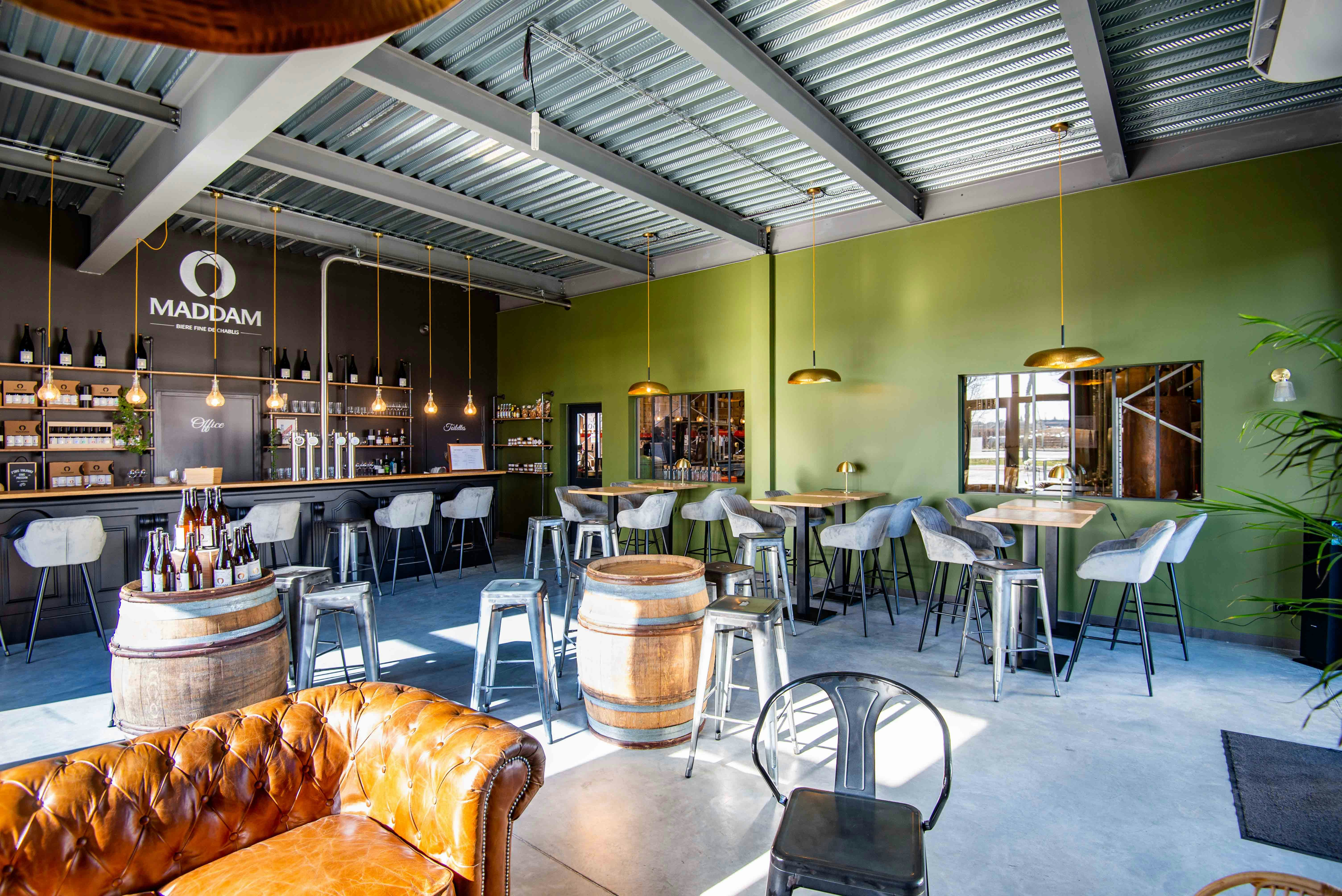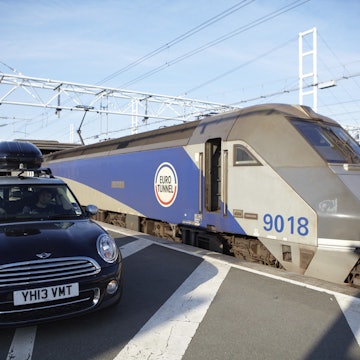
Burgundy is famous for vineyards - but here's why you should visit its burgeoning beer trail

May 5, 2023 • 5 min read

Head to Maddam to try Burgundy's beers © Nathalia Guimaraes
Burgundy (Bourgogne in French) is quite literally synonymous with wine. Not just any wine, either: the bottles produced here are some of the most prized on the planet.
This beautiful vine-covered region is home to nearly a quarter of France’s wines with the coveted AOC (Appellation d’Origine Contrôlée) designation, which means they meet stringent regulations about their origin, methods and growing conditions. Dozens are hierarchy-topping grands crus, aged in oak barrels then bottles, often for decades.
Today, there’s a twist afoot in Burgundy. The region’s peerless passion and painstaking craftsmanship is being poured into brewing – drawing on terroir, techniques and historical links to blaze a new trail for artisanal beer across Burgundy.

You've probably heard of Burgundy's famous wine trails...
Maybe you've heard of Burgundy’s wine trails, such as the prestigious châteaux along the Route des Grands Crus, with their exceptional reds (made from pinot noir grapes) and whites (chardonnay).
In any case, wine is all but impossible to avoid: viticultural heritage seeps all across Burgundy. Vines were first planted in Gallo-Roman days. Medieval monks made wine here during Charlemagne’s reign for the church and aristocratic Dukes of Burgundy, whose vast territory extended to Flanders.
Today, Burgundy’s burgeoning brewing landscape is a sort of return to these ducal roots. Cervoise was the pre-beer brew of choice for centuries, until the early 15th-century Duke of Burgundy Jean sans Peur (John the Fearless) created the Ordre du Houblon (Order of Hops), instituting the use of hops for their antiseptic and aromatic qualities to stabilize the output. With the fertile land producing cereal crops, brewing took off.
Yet the region’s breweries evaporated once industrialization arrived in the 1950s. It’s only in this century that artisanal brewing has been revived. And it’s thriving, thanks to a blend of know-how developed from wine making, regional add-ins like blackcurrant and gingerbread – and revolutionary new ideas.
Today, there are dozens of creative enterprises on Burgundy’s (re-)emerging beer map, and a bottle will certainly set you back less than the region’s most famous vintages.

... but its burgeoning beer trail is worth the visit
Of course, serious oenophiles won’t want to skip Burgundy’s wine trails but there's no harm in trying both. Starting and ending in Burgundy’s magnificent capital, Dijon, you can visit all of these breweries’ tap rooms and shops along this 310-mile (500km) route des bières artisanales de Bourgogne (Burgundy craft-beer trail). You should also feel free to customize your own itinerary by picking among them.
In an old flour mill opposite Dijon’s Cité Internationale de la Gastronomie et du Vin, dried hops hang from the roof, and a viewing window looks out over the vats, at Un Singe en Hiver. Only organic malts and hops are used to create beers like La Crème de la Crème (amber pale ale made from raw hops), Le Goût de la Réglisse (Belgian-inspired dubbel with green aniseed) and Monsieur Jack (porter with honey, cloves and gingerbread)
On Dijon’s northern edge is 90 BPM Brewing Co, where brewers Léo and Victor age beers in Burgundy wine barrels. The 15 on tap include Les Feux de la Mure (sour hazy made with blackberry) and Super Pschitten (Czech-style pilsner from traditional local hop tardif de Bourgogne), which you can drink in the courtyard over a game of pétanque.
Just outside Dijon to the southeast, Brasserie Elixkir specializes in blondes, IPAs, tripels and stouts (some barrel-aged). Also to the southeast, Independent House uses local ingredients to make international styles like American IPAs, English stouts and Dutch lagers. To the south, Brasserie des Trois Fontaines collaborates with farmers to cultivate barley and Burgundian hops, and resurrects old recipes using local ingredients like eau-de-vie de marc brandy in bottle-fermented beers.
Deep in grand cru wine country south of Dijon, “nanobrewery” Modéliacus employs a sustainable ethos (right down to crackers made from spent beer grains) in brews such as its hoppy Bière de Recotte: a favorite with grape pickers during the vendange (wine harvest).
Further south along the Route des Grands Crus, VIF takes its cues from bottom-fermented German beers (such as Leicht, a low-alcohol Kölsch) and American craft ales (like L’Ouest, a Californian-style pale ale). What’s more, its eco-friendly cans are designed by a local watercolorist.
In the rampart-ringed viticultural “capital” Beaune, Belenium, founded by three friends, is the medieval town’s first artisanal microbrewery. Its beers include Blonde au Cassis (blackcurrant blonde), La Blanche de Blanche (wheat beer) and Ambrée Numéro 2 (amber with cloves and cardamom).
Heading southwest to Chamilly, in a former cooperage La BAB (Brasserie Artisanale de Bourgogne) makes organic, top-fermented, unfiltered, unpasteurized beers like Festiv’Ale Blonde, Flor’Ale Rousse (red ale) and Jovi’Ale Dorée (golden ale).
A 17th-century barn in Sennecey-le-Grand is the home of Ammonite, where Simon Lecomte deploys his viticulture and oenology studies. He follows the lunar calendar to create wild-fermented beers with local produce (like apricots, blackcurrants and raspberries), aged for up to three years in wine and Marc de Bourgogne brandy barrels.
In abbey-famed Tournus, brewer and chef duo Two Dudes hosts private beer-pairing dinners in its fermentation room surrounded by vats.
Burgundy’s sprawling Parc Naturel Régional du Morvan, a protected area of woodland, lakes and farmland, shelters Tipsy Brewing, whose beers such as Tripel du Morvan are made with spring water from the park.
Beneath Vézelay’s Unesco World Heritage–listed hilltop basilica, with sweeping views from its terrace, Brasserie de Vézelay brews with water drawn from a nearby well plus local malt and hops (leftover cereals are given to farmers for animal feed). Its range of gluten-free ales span blonde, white, amber and brown.

In celebrated wine town Chablis, Maddam creates wild-fermented organic beers from local hops and fruits aged in oak barrels. All reference local landmarks, like Moulin des Fées (wheat beer named for a nearby watermill) and Jardins du Prieuré (amber ale named for the priory gardens).
Exquisite Middle Ages treasure Semur-en-Auxois is the setting for Les Bières du Donjon, whose team combines medieval brewing techniques (offerings include a pre-hops cervoise, as well as a white beer with rosebuds) with all-French ingredients such as sage, sweet mint and cloves.
Back in Dijon, the Craft Beer Pub has over 50 primarily local artisanal beers by the bottle as well as 11 rotating on the taps.
This might be enough for multiple trips.
How to make it happen
Dijon is easily reached by high-speed train from destinations including Paris, with its international bus, train and flight links; and Lyon, which also has onward connections throughout Europe. A car is the easiest way to get around Burgundy; to avoid imbibing and driving, accommodations are plentiful along every route.















